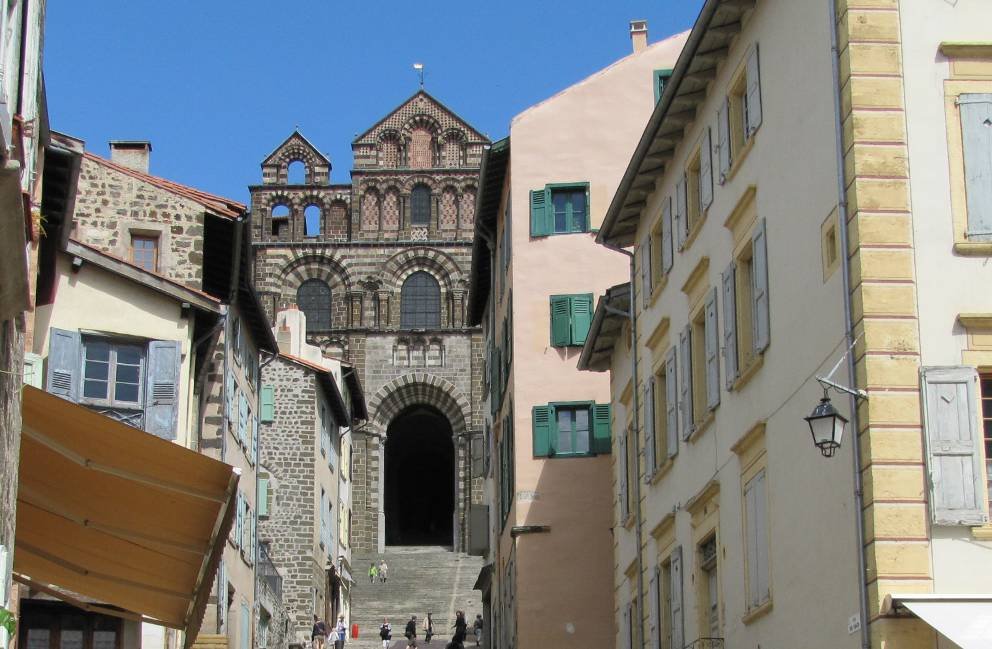
Le Puy en Velay
Historic French pilgrimage city
- Explore France ►
- Essential pages
- Travel in France
- Where to go
- What to see and do
About-France.com
- the connoisseur's guide to France
Discover Le Puy - things to see and do
Starting
point for the medieval pilgrimage trail to Santiago de Compostella, Le
Puy en Velay is a fascinating small city, with a remarkable heritage
| On this page | Location and access | Tourist attractions |
| In the area | Le Puy accommodation |
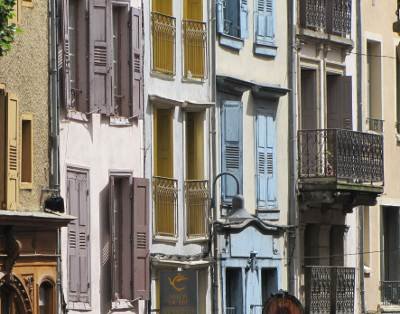
Houses in the historic quarter of Le Puy en Velay
The first European "tourists" were pilgrims; and it was in Le Puy en Velay that many of the early pilgrims gathered for the start of the arduous journey to the shrine of Santiago de Compostela, the great medieval pilgrimage destination in Galicia, Spain.
The first pilgrimages set out from Le Puy in the late tenth century, and during the Middle Ages, the city became a major religious centre, the great starting point for one of the major Compostella pilgrimage routes, the Via Podiensis.
It was in the cathedral at Le Puy, in 1095, that Pope Urban II announced the preparation of the First Crusade.
While the idea of trekking to Santiago faded away for centuries after the Middle Ages, becoming a task only to be under taken by the very devoted or (fool)hardy, it is now well back in fashion. Today, Le Puy has returned to its important position as the starting point for the greatest European pilgrimage route, a hiking trail of over 1000 km undertaken each year, in whole or in part, by many thousands of pilgrims or hikers. Baggage portage facilities are available all along the Via Podiensis from LaMallePostale.com.
But while le Puy attracts many hikers and pilgrims, preparing to set off for Compostella, or at least walk some of the trail, there is no need to be a hiker to visit this lovely small city. Le Puy boasts some remarkable historic monuments, and the cathedral area is classed as a UNESCO world heritage site.
Sites
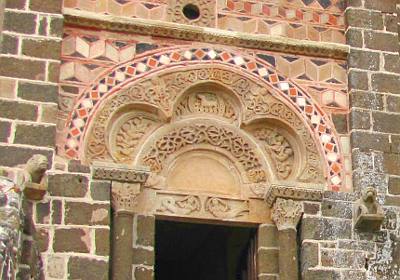
10th century door of the Chapel of St Michael
Larger, but also only accessible up steps, is the twelfth century Cathédrale Notre Dame, one of the greatest and most distinctive Romanesque cathedrals in France. Due to its situation on the side of the "puy", the main entrance to the cathedral is in the basement, and visitors must then climb up stairs, to emerge in the middle of the cathedral.
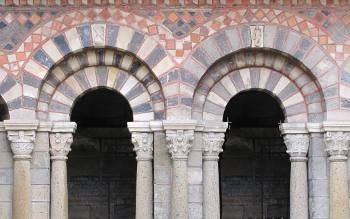
11th century cloisters, le Puy cathedral
The same intricate use of polychrome stonework can be seen in the cathedral cloisters, built in the 12th century, and certainly the most distinctive cloisters in France, if not in Europe.
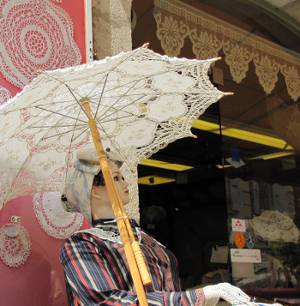
Le Puy lace
The old city of Le Puy is a delightful maze of small streets, flanked by tall houses painted in pastel colours. There are lots of small shops, antique shops and cafés, and visitors can also see lacemakers at work, le Puy having been famed for centuries as a centre for lace making. The tradition still survives to this day.
Le Puy's Musée Crozatier museum has a substantial collection of 19th century French art and a large collection of artefacts and of geological interest.
Le Puy is located about in the Massif Central mountains about 100 km southwest of Lyon, and 150 km south of Clermont Ferrand.
Access
By air Le Puy is not the easiest of
French cities to get to. Le-Puy–Loudes airport has two
flights a day (weekdays) to and from Paris Orly. Other than that, the
best solution is to fly to Lyon Saint
Exupéry airport, and take the train or hire a
car.
By
train : From Paris or Lyon, take the TGV to Saint-Etienne,
where there are connections by local train to Le Puy. The railway
between Saint Etienne and Le Puy is slow but very scenic, following the
Loire
Gorge from just after Firminy as far as the outskirts of Le Puy. Le Puy
can also be reached by local train from Clermont Ferrand; the route is
also slow, but scenic. For timetables and online tickets,
see Trainline.com .
By
road : Le Puy is located on the N88 trunk road which runs
from Lyon to Toulouse. The N88 is mostly dual carriageway between Le
Puy and Saint Etienne, where it joins the A47 motorway.
Le Puy also lies on the N102, linking Clermont-Ferrand and
Montélimar. This is on part of the recommended no tolls route
from northern France to Provence.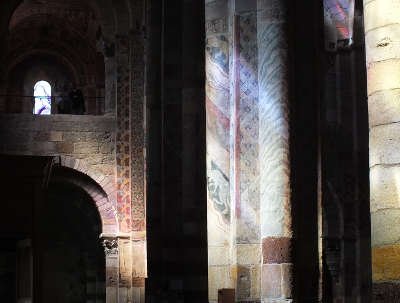
The medieval basilica of St Julian, Brioude
Northeast of le Puy, the small town of Brioude is one of the prettiest small towns in France, with a remarkable Romanesque basilica (three stars in the Michelin guide), and a prestigeous new arts centre opened in 2018.
More generally, le Puy is surrounded by the uplands of the Auvergne region, an area with huge opportunities for outdoor activities of all kinds.
About-France.com
Home page -
Site search
- Regions
- Maps of France
- Contact
Photo top of page : Photo
above : For over a thousand years pilgrims have climbed the
steps
up to the Byzantine-style cathedral at Le Puy en Velay.
Region: Auvergne
Nearby cities: Saint Etienne, Clermont-Ferrand
Nearest airports: Lyon, Clermont-Ferrand
Le Puy en Velay is on the routes between:
Paris and Provence, via Clermont Ferrand.
Population:
City 18,500 Urban area: 73,000
Main sites: The Cathedral, the Cathedral cloisters, Saint Michel de l'Aiguilhe, the statue of Notre Dame de France, the old city.
Nearby attractions: Château-fort de Polignac, Château de La Rochelambert,
Gorges de la Loire, Mont Mezenc.
Altitude: 600 - 880 metres
Other accommodation options
Holiday cottages near le Puy
See Gitelink - Gites in Auvergne
Overnight stopover?
Click for B&B directory
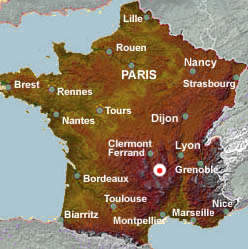
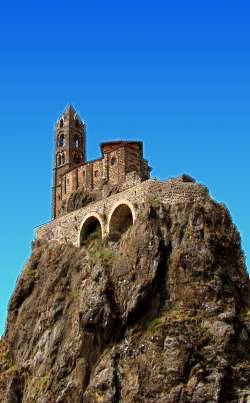
Dramatically sited 10th century chapel of St.Michel de l'Aiguilhe, built in the year 969
Copyright texts and photos © About-France.com 2007 - 2025
Le
Puy en Velay in a nutshell:
Region: Auvergne
Nearby cities: Saint Etienne, Clermont-Ferrand
Nearest airports: Lyon, Clermont-Ferrand
Le Puy en Velay is on the routes between:
Paris and Provence, via Clermont Ferrand.
Population:
City 18,500 Urban area: 73,000
Main sites: The Cathedral, the Cathedral cloisters, Saint Michel de l'Aiguilhe, the statue of Notre Dame de France, the old city.
Nearby attractions: Château-fort de Polignac, Château de La Rochelambert,
Gorges de la Loire, Mont Mezenc.
Altitude: 600 - 880 metres
Accommodation
in Le Puy
Check
out a choice of
Hotels in Le Puy en Velay
Hotels in Le Puy en Velay
Other accommodation options
Holiday cottages near le Puy
See Gitelink - Gites in Auvergne
Overnight stopover?
Click for B&B directory
About-France.com
is an independent user-supported website, and
may receive commission from sales made
on selected partner websites accessible through
affiliate links.


Dramatically sited 10th century chapel of St.Michel de l'Aiguilhe, built in the year 969
Click here for
low-cost car hire in France
low-cost car hire in France
Copyright texts and photos © About-France.com 2007 - 2025
